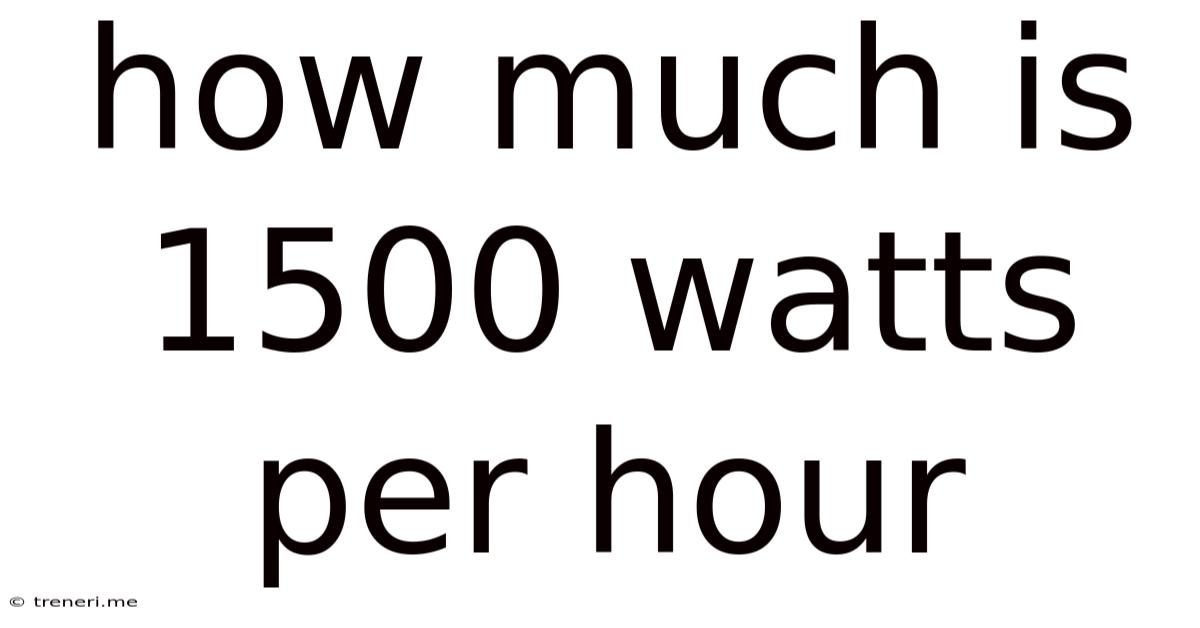How Much Is 1500 Watts Per Hour
Treneri
May 10, 2025 · 4 min read

Table of Contents
How Much is 1500 Watts Per Hour? Understanding Power and Energy
The question "How much is 1500 watts per hour?" often arises when dealing with electricity consumption. It's a seemingly simple question, but understanding the answer requires grasping the difference between power (watts) and energy (watt-hours). This article will thoroughly explain the concept, provide clear calculations, and offer practical applications to help you better understand your electricity usage.
Watts vs. Watt-Hours: The Crucial Difference
The confusion often stems from the misuse of units. Watts (W) measure power, which is the rate at which energy is used or produced. Think of it like the speed of a car – it tells you how quickly you're covering distance, but not the total distance traveled.
Watt-hours (Wh) or kilowatt-hours (kWh), on the other hand, measure energy, which is the total amount of power consumed over a period. This is analogous to the total distance traveled by the car.
Therefore, "1500 watts per hour" is technically incorrect. 1500 watts is a measure of power, not energy. It describes the rate of energy consumption. To express energy, you need to specify the time duration.
Calculating Energy Consumption: 1500 Watts for One Hour
If a device consumes 1500 watts of power for one hour, the energy consumed is:
Energy (Wh) = Power (W) × Time (h)
Energy (Wh) = 1500 W × 1 h = 1500 Wh
This means that a 1500-watt appliance running for one hour consumes 1500 watt-hours of energy. This is equivalent to 1.5 kilowatt-hours (kWh), since 1 kWh = 1000 Wh.
Calculating Energy Consumption for Different Time Periods
Let's expand this calculation for different time periods:
- 1500 Watts for 2 Hours: 1500 W × 2 h = 3000 Wh = 3 kWh
- 1500 Watts for 0.5 Hours (30 minutes): 1500 W × 0.5 h = 750 Wh = 0.75 kWh
- 1500 Watts for 10 Hours: 1500 W × 10 h = 15000 Wh = 15 kWh
- 1500 Watts for 24 Hours: 1500 W × 24 h = 36000 Wh = 36 kWh
Real-World Examples of 1500-Watt Appliances
Many household appliances have power ratings around 1500 watts. Examples include:
- High-power microwave ovens: Some microwave ovens operate at 1500 watts or more for quick and efficient cooking. Running one for 10 minutes would use approximately 250 Wh (1500 W * 10/60 h).
- Hair dryers: Powerful hair dryers often have power ratings in this range. The energy consumption depends heavily on usage time.
- Space heaters: These are designed to provide quick heating; 1500 watts is a common power rating. Energy use depends on how long the heater operates.
- Electric kettles: While smaller kettles might have lower wattages, larger ones can easily reach 1500 watts for fast boiling.
The Cost of Running a 1500-Watt Appliance
The actual cost of running a 1500-watt appliance depends on your electricity price per kWh. Electricity prices vary significantly by location and time of year.
To calculate the cost:
Cost = Energy (kWh) × Price per kWh
For example, if your electricity costs $0.15 per kWh and you run a 1500-watt appliance for one hour (1.5 kWh):
Cost = 1.5 kWh × $0.15/kWh = $0.225
Running the same appliance for 10 hours would cost:
Cost = 15 kWh × $0.15/kWh = $2.25
Remember to check your electricity bill for your specific rate to get the most accurate estimate.
Understanding Your Electricity Bill
Your electricity bill typically details your energy consumption in kilowatt-hours (kWh). By understanding the relationship between watts, watt-hours, and kilowatt-hours, you can better interpret your bill and identify areas where you can conserve energy.
Energy Conservation Tips
Reducing your energy consumption is not only environmentally friendly but also saves you money. Here are some helpful tips:
- Use energy-efficient appliances: Look for appliances with high energy efficiency ratings.
- Turn off lights and electronics when not in use: Unnecessary energy consumption adds up over time.
- Unplug chargers when not charging: Even when not actively charging, many chargers continue to consume a small amount of power (phantom load).
- Use power strips: Power strips allow you to easily turn off multiple devices at once.
- Use energy-efficient light bulbs: LED bulbs use significantly less energy than incandescent bulbs.
Advanced Concepts: Power Factor
For more complex scenarios, particularly with AC circuits and certain types of electrical loads (like motors), the concept of power factor comes into play. Power factor represents the ratio of real power (used to do work) to apparent power (total power supplied). A lower power factor means some of the supplied power is not effectively used, leading to higher energy consumption for the same amount of work done.
Conclusion: 1500 Watts is a Rate, Not a Quantity
The key takeaway is that 1500 watts represents the rate of energy consumption, not the total energy consumed. To determine the total energy, you must multiply the power (in watts) by the time (in hours). Understanding this distinction is crucial for accurately calculating energy consumption, understanding your electricity bills, and making informed decisions about energy usage and conservation. By applying the knowledge presented here, you can gain control over your energy costs and reduce your environmental impact.
Latest Posts
Latest Posts
-
How Many Hours Is Seven Days
May 10, 2025
-
What Is 90 Days From June 11 2024
May 10, 2025
-
How Many Seconds In 18 Years
May 10, 2025
-
How Many Days Is 568 Hours
May 10, 2025
-
75 Rounded To The Nearest 10
May 10, 2025
Related Post
Thank you for visiting our website which covers about How Much Is 1500 Watts Per Hour . We hope the information provided has been useful to you. Feel free to contact us if you have any questions or need further assistance. See you next time and don't miss to bookmark.